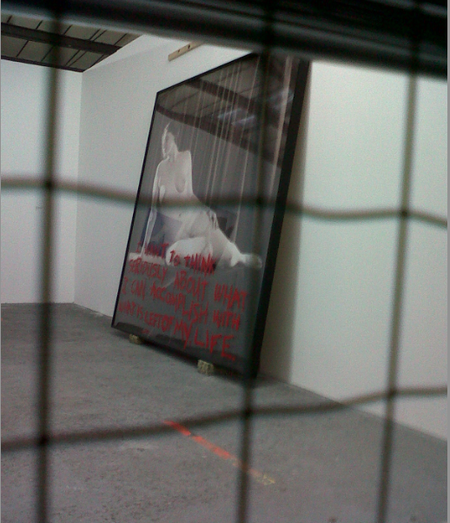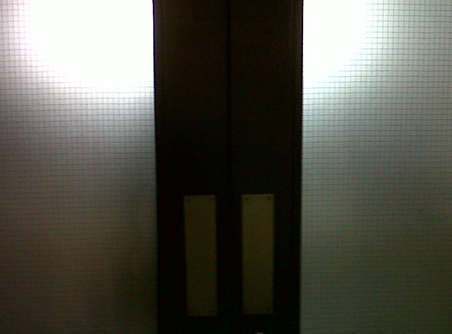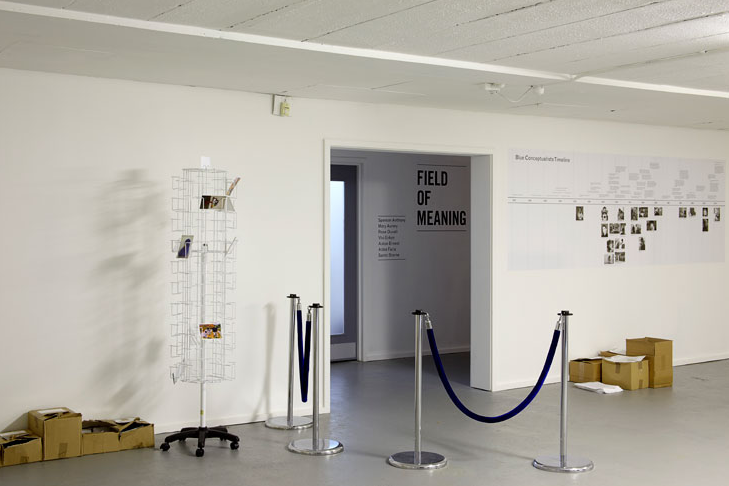You walk into a warehouse and there are teenagers perched on the steps. You walk through a door that leads you into a corridor that should take you into the exhibition that you never see. Everything is closed. You enter a room with a timeline - it talks about a movement called Blue Conceptualism - the colour looks Yves Klein familiar. It tells the story of artists you've never heard of, but they seem important - their lives have been marked out on a line, and they were a group. There are stacks of press releases with their names on it, publicizing the exhibition we will not see: Field of Meaning, at the so-called Kimberling Gallery. Nearby, there are postcards with images of the works in this unseen show. There's a big blue monster in one picture, it reminds me of Mark Dion's hanging mole, (Les Nécrophores – L'enterrement (Hommage à Henri Fabre), 1997). You look at a piece of paper on one of the stacked cardboard boxes - it's a crumpled up seating plan for the opening dinner. One VIP guest needed a plus two, for his women, you see. Then, you look into the office through the window - the lights are on, the computer is on, there's a fresh copy of the Economist on the table, but no one is there.
As we delve deeper into this unknown place, achingly hip art-teenagers are accusing the rude boy and rude girl as being part of the act, which they are, and in hindsight, so are those art teenagers, or at least, maybe that's what Gander wants me to think. In the end, it's as if everyone is in on it, this great farce. Nothing is real. You stare and stare at those closed, frosted doors, at those teasing silhouettes behind them, as if willing your eyes to burn those silhouettes through to the side of the real, your side - as if you were powerful enough to insist on your right to see what it is they are seeing. Through one corridor, you reach a glass door - it cuts you off from the main space. On a sheet of newspaper behind the glass, a number of mobile phones. One of them is ringing. Then another. And it goes on, this confusion. Until you retrace your steps, checking constantly for another way in, an opening you might have missed. Then out into the light, you check behind the warehouse just in case, where someone has written sorry to Mary Aurory on the wall.
When you get back to where you started - behind the metal gates that separate this strange place from the road, you find a crumpled sheet left on your companion's bicycle. It's a page from a book. I think it was a novel called English, All too English. Someone has circled three words for your attention. "Big blue monster".
As we delve deeper into this unknown place, achingly hip art-teenagers are accusing the rude boy and rude girl as being part of the act, which they are, and in hindsight, so are those art teenagers, or at least, maybe that's what Gander wants me to think. In the end, it's as if everyone is in on it, this great farce. Nothing is real. You stare and stare at those closed, frosted doors, at those teasing silhouettes behind them, as if willing your eyes to burn those silhouettes through to the side of the real, your side - as if you were powerful enough to insist on your right to see what it is they are seeing. Through one corridor, you reach a glass door - it cuts you off from the main space. On a sheet of newspaper behind the glass, a number of mobile phones. One of them is ringing. Then another. And it goes on, this confusion. Until you retrace your steps, checking constantly for another way in, an opening you might have missed. Then out into the light, you check behind the warehouse just in case, where someone has written sorry to Mary Aurory on the wall.
When you get back to where you started - behind the metal gates that separate this strange place from the road, you find a crumpled sheet left on your companion's bicycle. It's a page from a book. I think it was a novel called English, All too English. Someone has circled three words for your attention. "Big blue monster".
images courtesy of the Para-Institutional Archive





 RSS Feed
RSS Feed